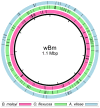Endosymbiont DNA in endobacteria-free filarial nematodes indicates ancient horizontal genetic transfer
- PMID: 20543958
- PMCID: PMC2882956
- DOI: 10.1371/journal.pone.0011029
Endosymbiont DNA in endobacteria-free filarial nematodes indicates ancient horizontal genetic transfer
Abstract
Background: Wolbachia are among the most abundant symbiotic microbes on earth; they are present in about 66% of all insect species, some spiders, mites and crustaceans, and most filarial nematode species. Infected filarial nematodes, including many pathogens of medical and veterinary importance, depend on Wolbachia for proper development and survival. The mechanisms behind this interdependence are not understood. Interestingly, a minority of filarial species examined to date are naturally Wolbachia-free.
Methodology/principal findings: We used 454 pyrosequencing to survey the genomes of two distantly related Wolbachia-free filarial species, Acanthocheilonema viteae and Onchocerca flexuosa. This screen identified 49 Wolbachia-like DNA sequences in A. viteae and 114 in O. flexuosa. qRT-PCR reactions detected expression of 30 Wolbachia-like sequences in A. viteae and 56 in O. flexuosa. Approximately half of these appear to be transcribed from pseudogenes. In situ hybridization showed that two of these pseudogene transcripts were specifically expressed in developing embryos and testes of both species.
Conclusions/significance: These results strongly suggest that the last common ancestor of extant filarial nematodes was infected with Wolbachia and that this former endosymbiont contributed to their genome evolution. Horizontally transferred Wolbachia DNA may explain the ability of some filarial species to live and reproduce without the endosymbiont while other species cannot.
Conflict of interest statement
Figures



Similar articles
-
Localization of Wolbachia-like gene transcripts and peptides in adult Onchocerca flexuosa worms indicates tissue specific expression.Parasit Vectors. 2013 Jan 2;6:2. doi: 10.1186/1756-3305-6-2. Parasit Vectors. 2013. PMID: 23281896 Free PMC article.
-
Absence of the Filarial Endosymbiont Wolbachia in Seal Heartworm (Acanthocheilonema spirocauda) but Evidence of Ancient Lateral Gene Transfer.J Parasitol. 2016 Jun;102(3):312-8. doi: 10.1645/15-872. Epub 2016 Feb 9. J Parasitol. 2016. PMID: 26859724
-
Comparing the mitochondrial genomes of Wolbachia-dependent and independent filarial nematode species.BMC Genomics. 2012 Apr 24;13:145. doi: 10.1186/1471-2164-13-145. BMC Genomics. 2012. PMID: 22530989 Free PMC article.
-
Wolbachia bacterial endosymbionts of filarial nematodes.Adv Parasitol. 2005;60:245-84. doi: 10.1016/S0065-308X(05)60004-8. Adv Parasitol. 2005. PMID: 16230105 Review.
-
Wolbachia endosymbionts and human disease control.Mol Biochem Parasitol. 2014 Jul;195(2):88-95. doi: 10.1016/j.molbiopara.2014.07.004. Epub 2014 Jul 18. Mol Biochem Parasitol. 2014. PMID: 25046729 Review.
Cited by
-
Onchocerca armillata contains the endosymbiotic bacterium Wolbachia and elicits a limited inflammatory response.Vet Parasitol. 2010 Dec 15;174(3-4):267-76. doi: 10.1016/j.vetpar.2010.08.031. Epub 2010 Sep 17. Vet Parasitol. 2010. PMID: 20850932 Free PMC article.
-
Retrotransposition facilitated the establishment of a primary plastid in the thecate amoeba Paulinella.Proc Natl Acad Sci U S A. 2022 Jun 7;119(23):e2121241119. doi: 10.1073/pnas.2121241119. Epub 2022 May 31. Proc Natl Acad Sci U S A. 2022. PMID: 35639693 Free PMC article.
-
The Genome of the Fungal Pathogen Verticillium dahliae Reveals Extensive Bacterial to Fungal Gene Transfer.Genome Biol Evol. 2019 Mar 1;11(3):855-868. doi: 10.1093/gbe/evz040. Genome Biol Evol. 2019. PMID: 30799497 Free PMC article.
-
Iron necessity: the secret of Wolbachia's success?PLoS Negl Trop Dis. 2014 Oct 16;8(10):e3224. doi: 10.1371/journal.pntd.0003224. eCollection 2014 Oct. PLoS Negl Trop Dis. 2014. PMID: 25329055 Free PMC article. Review.
-
Suppression of cytoplasmic incompatibility in the leaf-mining fly Liriomyza sativae with a nuclear Wolbachia insert.R Soc Open Sci. 2025 May 21;12(5):242137. doi: 10.1098/rsos.242137. eCollection 2025 May. R Soc Open Sci. 2025. PMID: 40400517 Free PMC article.
References
-
- Taylor MJ, Bandi C, Hoerauf A. Wolbachia bacterial endosymbionts of filarial nematodes. Adv Parasitol. 2005;60:245–284. - PubMed
-
- Hoerauf A, Mand S, Fischer K, Kruppa T, Marfo-Debrekyei Y, et al. Doxycycline as a novel strategy against bancroftian filariasis-depletion of Wolbachia endosymbionts from Wuchereria bancrofti and stop of microfilaria production. Med Microbiol Immunol. 2003;192:211–216. - PubMed
-
- Kozek WJ. Transovarially-transmitted intracellular microorganisms in adult and larval stages of Brugia malayi. J Parasitol. 1977;63:992–1000. - PubMed
Publication types
MeSH terms
Substances
Grants and funding
LinkOut - more resources
Full Text Sources

